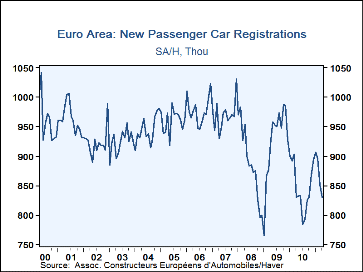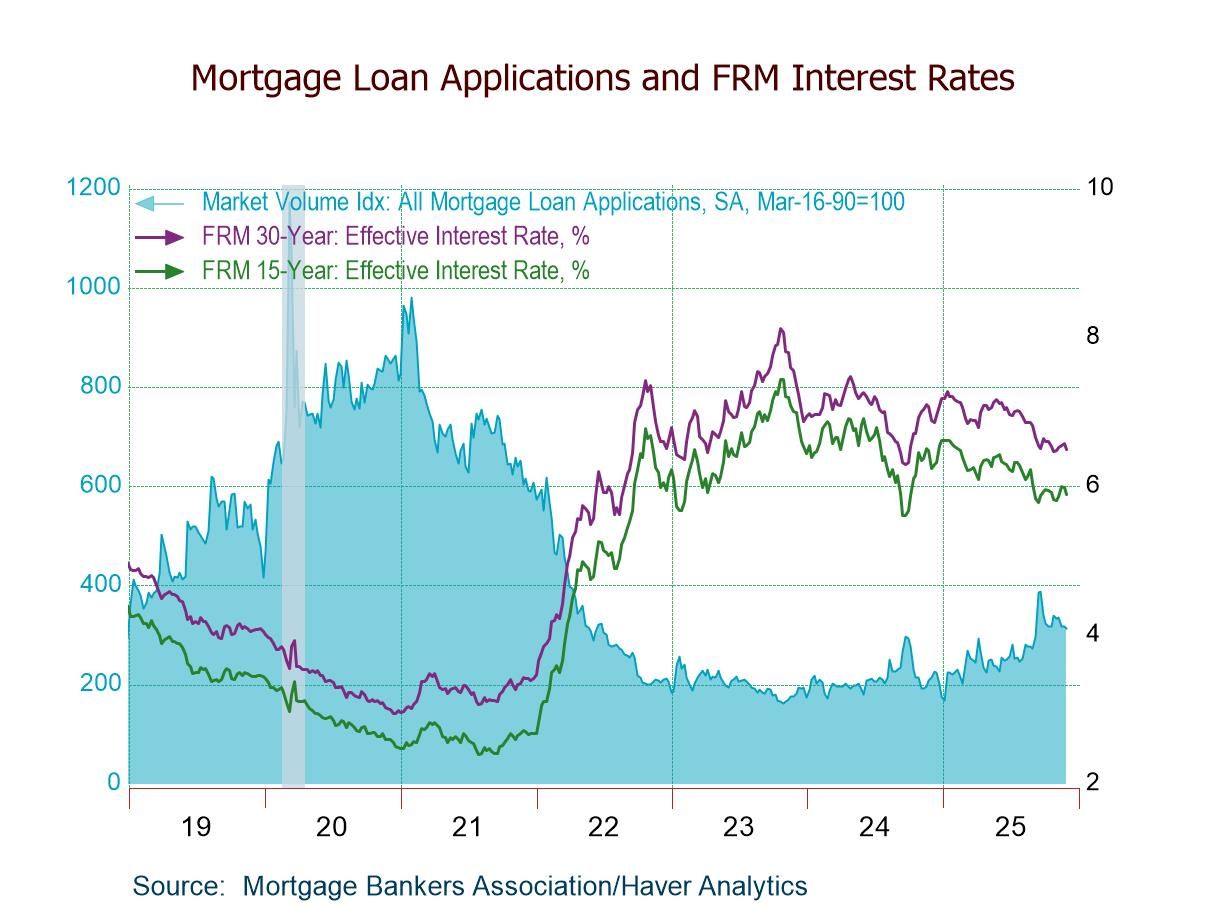 Global| Jun 02 2011
Global| Jun 02 2011Euro-Area Auto Sales/Registrations Hit the Skids...
Summary
The most topical car registration data are for Spain and Italy in May (not in the table). Sales in Italy rebounded by 3.1% in May as sales in Spain continued weak and fell by 0.3% in May. France and Spain are seeing government [...]
 The most topical car registration data are for Spain and Italy in May (not in the table). Sales in Italy rebounded by 3.1% in May
as sales in Spain continued weak and fell by 0.3% in May. France and Spain are seeing government subsidies expire in May and that
should contribute to further weakness.
The most topical car registration data are for Spain and Italy in May (not in the table). Sales in Italy rebounded by 3.1% in May
as sales in Spain continued weak and fell by 0.3% in May. France and Spain are seeing government subsidies expire in May and that
should contribute to further weakness.
Auto registrations pull back- Amid all the concerns about Europe and its debt problems it has not been a good time buy an automobile. Moody's has now put the probability of a default in Greece at 50/50. That will do nothing to try and shore up confidence in the Zone. Buying an automobile has always required some degree of consumer confidence. But as we have demonstrated in recent months, only Germany has a reasonably strong level of consumer confidence across the zone. And while that has not made its car sales/registrations any better in recent months, it explains why Germany has the strongest Yr/Yr sales in the table, up by 8.3% to Italy's distant second best at +0.1%.
A very visible barometer goes sour- Car sales tell a lot about consumer confidence and what those sales are telling us now is not music to our ears.
Weakness persists and deepens- Over the most recent three months, Germany, France, and the UK have seen the most severe downturn in buying activity in the auto market. This is not good news since these are very large important EMU/EU economies. Not surprising then is the day's 5% drop in Peugeot's stock price or the 2% slide in the stock values at Volkswagen, Daimler and Renault.
Euro debt problems and the fickle finger of fate - With Greece in deeper trouble there are growing concerns that Ireland could be in its footsteps. The recent sharp weakness registered in the US simply adds to the notion that there is a big negative global shock out there and that everyone is reeling from it. That may divert the fickle finger of fate from pointing to firmly at the euro-debt crisis. But that concern is still out there and the economic slowdown –whatever its cause- appears to be real and as it endures it will naturally put more pressure on the weakest in the Zone exacerbating debt concerns. Markets are going to have to cope with the consequences. That could be difficult since the recovery has been much more on the back of manufacturing which now seems so troubled.
The end of recovery? - We are now clearly in a new phase of 'expansion.' And it is not what we would have expected. The recovery itself is far from complete. Yet, the 'recovery part of the early expansion has been disappointing and appears to be over...but the expansion phase should linger on.
Phases of the business cycle: where are we? - The business cycle resolves itself into two phases: expansion and contraction. The contraction phase is called recession. The expansion phase divides informally, into two parts, a recovery phase and a more moderate expansion phase (long term expansion). In the recovery phase, the economy usually grows very rapidly, faster than its long term growth rate, and in this way it sucks up some of the unused capacity that was created by recession in the capital and labor markets. The recovery phase is the early portion of the expansion. After the recovery phase the economy transitions, sometimes in a bumpy way, into the sustainable expansion phase when economic growth rates slow to a more sustainable pace as the degree of idle resources is usually more limited in the wake of a successful recovery phase.
One previous truncated cycle- Only once in the Post War period has the US economy shifted from the recovery phase directly into a new recession. That was a special circumstance after the 1980 recession when the Fed had shifted its operating procedures to take a passive role on interest rates and an active role in corralling money supply growth. That shift made in 1979 led interest rates to rise with extraordinary vigor early in the 1980 expansion (which was actually quite strong) choking it off before it could reach sustainability.
Where are we now? - One need not be much of an economic expert to see how poorly the usual paradigm description fits this expansion phase. Neither does the failed recovery description from 1980 qualify as the 'shoe that fits.'
A unique but not unprecedented recoveries- The growth rates in this recovery have not been substantial. While we have moved capital utilization and unemployment up from their lows in the US to some extent this 'progress' has been artificial as plants in the US have been mothballed for their lack of competitiveness and workers have left the labor force, some of them potentially permanently discouraged. Spain has seen its unemployment rate continue to rise. Greece is seeing a period of recovery turned to another slump. The situation in Europe is complicated by the relatively Euro-Area-wide decision to pursue fiscal austerity early in the recovery period. This acts as a premature brake to growth much as did Fed policy in the 1980 period. All of Europe is now slowing, perhaps rapidly.
Previous recession/recovery pairs- In the previous two US economic expansions following recessions the disappointing recoveries that each exhibited were followed by a more robust expansion period. That sort of 'phase shift' was made possible by those earlier two recoveries that were so weak. This recovery/expansion period may yet follow in those footsteps. But right now with global commodity prices stretched and oil prices, in particular, so high, the ongoing integration of the India and China into the world trading system and the spread of higher living standards there it does not seem so. These events have taken up some of the slack in resource usage faster than in the past. Historically, rising commodity prices would not have pressured economic recovery so soon. Moreover, it is not just the addition of the developing world's demand but the heightened financial system response and future's market trading that has pushed up prices on expectations that have outstripped actual demand.
Unusual recovery cycle braking - Undoubtedly the spike in commodity prices in this recovery is playing the role to some extent that Fed policy did in the truncated 1980 expansion when the Fed hiked rates so quickly early in the recovery period. That action, of course, led to the deeper and more persistent recession in 1981-1982. Still, the rise in commodity prices this time is nowhere near as restrictive as was Fed policy in that earlier period. But it does project some of those same effects and along with euro-austerity and developing economy demand it has played a role in the early braking of growth in the global expansion. And, of course, the unusual aftermath of the recession this time around is related to the hangover effect from the earlier (ongoing?) financial crisis, and the more recent negative supply shock from Japan is a brake as well and the US debt impasse may be yet another.
Will the special factors now wither? We can identify special factors that have held back the global recovery. But we do have central bankers working overtime to try and patch up the system. So even as the debt problems threaten to spill over we see herculean efforts still being made to stop the rush to default judgment. In this environment if consumers lose hope the government/central bank task will be made ever harder. This sort of consumer quandary puts auto sales in the lime light as an important and high frequency indicator we can monitor to see quickly if the banking system is reacting in a favorable way with the consumer. Both of those pieces are needed to propel auto sales forward. Right now the jury is out and the longer it is out the more we fear the verdict that it eventually will turn in.
11
11
11
11
11
11
11
11
11
11
11
11
11
11
11
11
11
11
Robert Brusca
AuthorMore in Author Profile »Robert A. Brusca is Chief Economist of Fact and Opinion Economics, a consulting firm he founded in Manhattan. He has been an economist on Wall Street for over 25 years. He has visited central banking and large institutional clients in over 30 countries in his career as an economist. Mr. Brusca was a Divisional Research Chief at the Federal Reserve Bank of NY (Chief of the International Financial markets Division), a Fed Watcher at Irving Trust and Chief Economist at Nikko Securities International. He is widely quoted and appears in various media. Mr. Brusca holds an MA and Ph.D. in economics from Michigan State University and a BA in Economics from the University of Michigan. His research pursues his strong interests in non aligned policy economics as well as international economics. FAO Economics’ research targets investors to assist them in making better investment decisions in stocks, bonds and in a variety of international assets. The company does not manage money and has no conflicts in giving economic advice.






